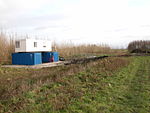Bad Nieuweschans
1628 establishments in the Dutch RepublicFormer municipalities of Groningen (province)Forts in the NetherlandsGermany–Netherlands border crossingsOldambt (municipality) ... and 2 more
Populated places in Groningen (province)Spa towns in the Netherlands

Bad Nieuweschans (also Lange Akkeren; Dutch pronunciation: [bɑt ˈniuʋəsxɑns]; Gronings: Nij-Schans; German: Bad Neuschanz) is a village in the north-eastern Netherlands on the border with Germany. It forms part of the municipality of Oldambt. Nieuweschans means "new fortification (sconce)". In 2009, the word Bad ("spa") was prefixed to the name of the village to promote it as a tourist destination.
Excerpt from the Wikipedia article Bad Nieuweschans (License: CC BY-SA 3.0, Authors, Images).Bad Nieuweschans
Stationsstraat, Oldambt
Geographical coordinates (GPS) Address Nearby Places Show on map
Geographical coordinates (GPS)
| Latitude | Longitude |
|---|---|
| N 53.183333333333 ° | E 7.2 ° |
Address
Stationsstraat
9693 AA Oldambt
Groningen, Netherlands
Open on Google Maps









